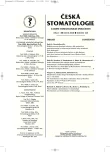Oral Mucositis as a Side Effect of Myeloablative Chemotherapy in Hemato-oncological Patients
Authors:
R. Pink 1; J. Pazdera 1; J. Vondráková 2; E. Faber 2; I. Skoumalová 2
Authors‘ workplace:
Klinika ústní, čelistní a obličejové chirurgie LF UP a FN, Olomouc
přednosta prof. MUDr. J. Pazdera, CSc.
1; Hemato-onkologická klinika LF UP a FN, Olomouc
přednosta prof. MUDr. K. Indrák, DrSc.
2
Published in:
Česká stomatologie / Praktické zubní lékařství, ročník 108, 2008, 1, s. 9-13
Overview
The group of 20 patients treated for non-Hodgkin lymphomas and multiple myeloma was examined by stomatologists before planned autologous transplantation of stem cells. After tooth sanation and removal of the sources of local irritation and potential foci of odontogenic focal infection the patients were observed in the course of 4 to 5 weeks after transplantation for the occurrence of oral mucositis. Oral mucositis of 1st to 2nd degree (according to NCI-CTC classification) became manifest in the course of hemato-oncological treatment in all patients in relation to the type of chemotherapy. After successful termination of hemato-oncological treatment a spontaneous disappearance of oral mucositis developed. Low seriousness of oral complications of hemato-oncological therapy confirms the importance of careful stomatological preparation of the patient before planned autologous transplantation.
Key words:
autologous transplantation - oral mucositis - hemato-onkological patient - chemotherapy
Sources
1. Sonis, S., Oster,G., Fuchs, H. et al. Oral mucositis and the clinical and economic outcomes of hematopoeitic stem – cell transplantation. Oncol., 2001, č.19, s. 2201-2205.
2. Sonis, S.: The pathology ofmucositis. Nat. Rev. Cancer, 2004, č. 4, s. 227-284.
3. Blijlevens, N., Donelly, J. P., De Pau, B. E.: Mucosal barrier injury: biology pathology clinical counterparts and consequences ofintensive treatment for haematological malignancy: an overwiev. Bone Marrow Transplant., 2000, č. 25, s. 1269–1278.
4. Stone, R., Quinn, B., McCann, S. et al.: Improving oral care in transplantation quality control of oral mucositis (OM) assesment in the EBMT prospective oral mucositis audit (POMA). Bone Marrow Transplantation, 2006, č. 37, Suppl. 1, s. N966.
5. Stockman, M. A., Sonis, S. T., Dijkstra, P. U. et al.: Assesment oforal mucositis in clinical trials: impact oftraining on avaluators in multi-centre trial. Eur. J. Cancer, 2005, č. 41, s. 1735-1738.
6. Rubenstein, E., Peterson, D., Schubert, M. et al.: Clinical practice guidelines for prevention and treatment of cancer therapy – induced oral and gastrointestinal mucositis. Cancer, 2004, č. 100, s. 2026-2046.
7. Vokurka, S., Bystřická, E., Koza, V. et al.: The comparative effects of providone-iodine and normal saline mouthwashes on oral mucositis in patiens after high-dose chemotherapy and APBSCT – results of a randomized multicentre study. Support Care Cancer, č. 13, s. 554-558.
8. Fine, D. H.: Mouthrinces as adjunct for plaque and gingivitis management. A status report for the American Journal of Dentistry, 1998, č. 1, s. 259-263.
9. Miller, T. F., Silva, A., Ferreira, S. M., Jabra-Rizk, M. A., Kelley, J. I., DePaola, L. G.: Efficacy of Listerine antiseptic in reducing viral contamination of saliva. J. Clin. Periodontol., 2005, č. 32, s. 341-346.
10. Walker, C., Clark, W., Tyler, K., Ross, N., Dill, S.: Evaluation of microbial shifts following long-term antiseptic mouthrinse use. Journal of Periodontology, 1997, č. 48., s. 646-649.
11. Minah, G. E., DePaola, L. G., Overholser, C. D., Miller, T. F., Niehaus, C., Lamm, R. A., Ross, N. M., Dills, S. S.: Effects of 6 months use of an antiseptic mouthrinse on supragingival dental plaque microflora. Journal of Clinical Periodontology, 1989, č. 15, s. 347-352.
12. Mahood, D. J., Dose, A. N., Loprinzi, C. L. et al.: Inhibition offluorouracil – induced stomatitis by oral cryotherapy. J. Clin. Oncol., 1991, č. 9, s. 449-452.
13. Cascinu, S., Fedeli, A., Fedeli, S. L. et al.: Oral cooling (cryotherapy), and effective treatment for prevention of5- fluorouracil induced stomatitis. Eur. J. Cancer B. Oral Oncology, 1994, č. 30B, s. 234-236.
14. Roche, L. K., Loprinzi, C. L., Lee, J. K. et al.: A randomized clinical trial of two different durations oforal cryotherapy for prevention of 5- fluorouracil – related stomatitis. Cancer, 1993, č. 72, s. 2234- 2238.
15. Krijanovski, O., Hill, G., Cooke, K. et al.: Keratinocyte growth factor separates graft- versus- leukemia effects from graft – versus- host- disease. Blood, 1999, č. 94, s. 825- 831.
16. Spielberger, R., Stiff, P., Bensinger, W. et al.: Palifermin for oral mucositis after intensive therapy for hematologic cancers. N. Engl. J. Med., 2004, č. 351, s. 2590-2598.
17. Barasch, A., Peterson, D. E., Tanzer, J. M. et al.: Helium- neon laser effects on conditioning induced oral mucositis in bone marrow transplantation patients. Cancer, 1995, č. 76, s. 2550-2556.
18. Cowen, D., Tardieu, C., Schubert, M. M. et al.: Low energy helium-neon laser in prevention oforal mucositis in patients undergoing bone marrow transplantation- results of double blind randomized trial. Ind. J. Radiad. Oncol. Biol. Phys., 1997, č. 38, s. 367-703.
19. Starosta, M., Faber, E.: Stomatitis u nemocných po autologní transplantaci hemopoetických kmenových buněk. Praktické zubní lékařství, roč. 48, 2000, č. 5, s. 131-136.
20. Bartáková, V.: Problémy stomatologického ošetřování u vybraných skupin rizikových pacientů, Čs. Stomat., 1986, roč. 86, č. 4, s. 255-260.
21. Mori, T., Yamazaki, R., Aisa, Y., Nakazato, T., Ikeda, Y., Okamoto, S.: Brief oral cryoterapy for the prevention of high-dose melphalan-induced stomatitis in allogeneic hematopoietic stem cell transplant recipients. Support Care Cancer 13, 2005, s. 266-269.
Labels
Maxillofacial surgery Orthodontics Dental medicineArticle was published in
Czech Dental Journal

2008 Issue 1
Most read in this issue
- Temporomandibular Point and Its 2D and 3D Models
- Dental Treatment in Children under General Anaesthesia
- Blockade of Nervus Alveolaris Inferior in 284 Patients with Semi-retained and Retained Lower Wisdom Teeth: Our Experience
- Oral Mucositis as a Side Effect of Myeloablative Chemotherapy in Hemato-oncological Patients
